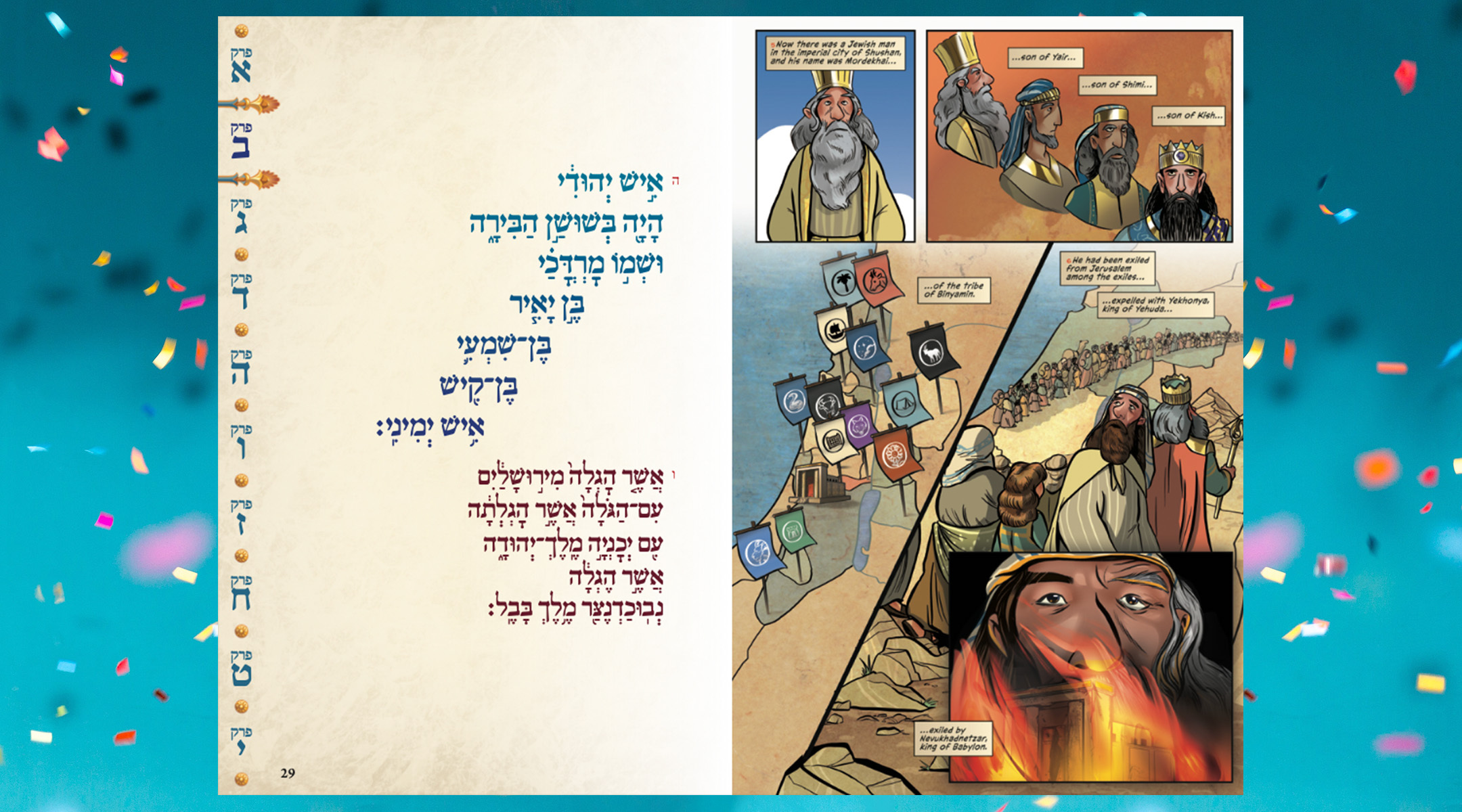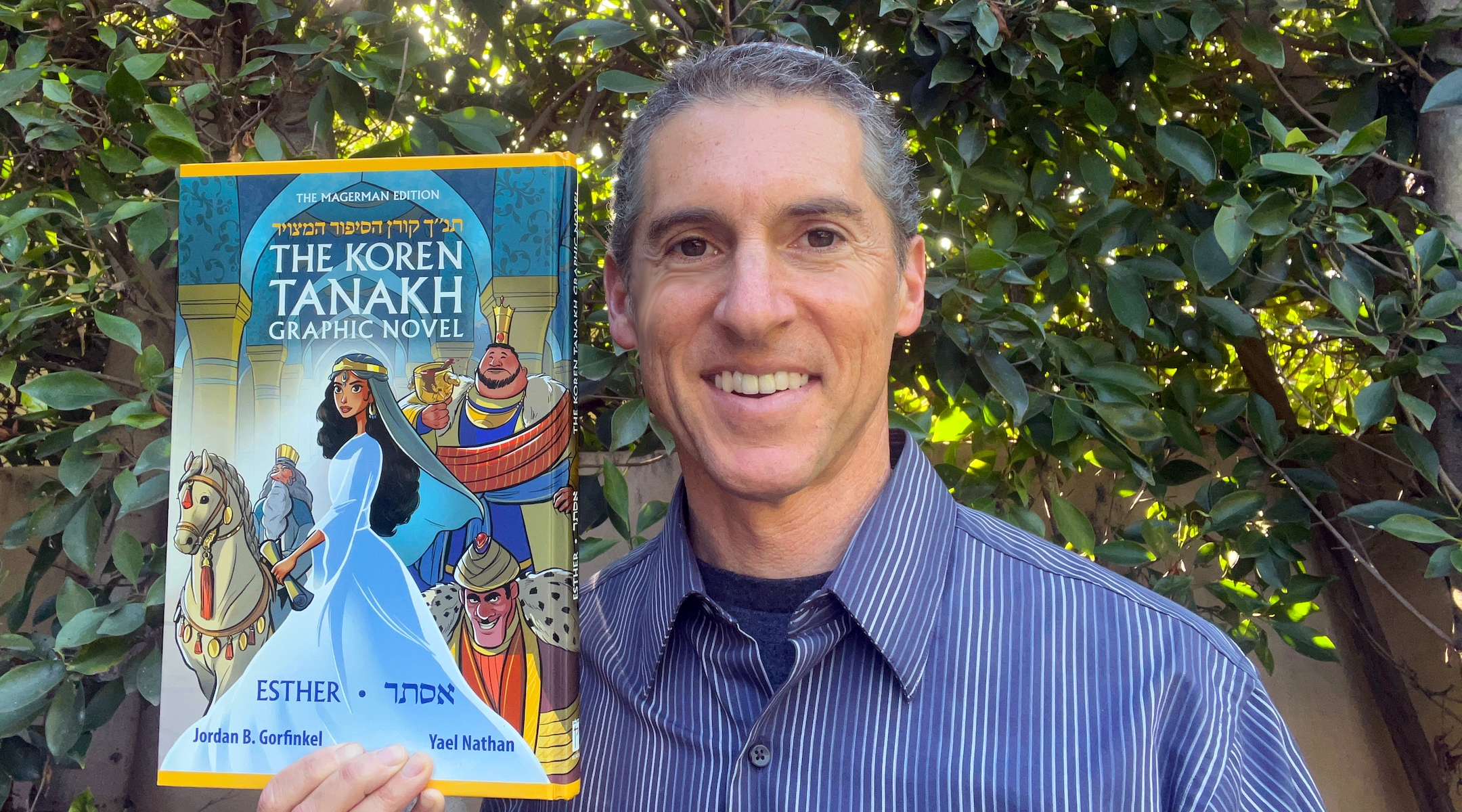A graphic novel of the Purim story, from a Batman comics editor
Jordan Gorfinkel edited the DC Batman franchise from 1991-99

A page from the “The Koren Tanakh Graphic Novel Esther” shows the Purim story in visual action. (Jordan B. Gorfinkel and Yael Nathan)
(JTA) — In 1996, Jordan Gorfinkel launched two series of comics that get at the two sides to his personality and career.
One was “Birds of Prey” — which has since been the basis for several television and film adaptations — that he created while overseeing the Batman franchise as an editor at DC Comics. (Another claim to fame during his tenure from 1991-99 was the creation of “Batman: No Man’s Land,” which served as inspiration for the 2012 Christopher Nolan blockbuster “Dark Knight Rises.”)
The other that he launched 1996 was “Jewish Cartoon,” an ongoing series of comics that poke fun and celebrate aspects of Jewish life and religious observance. To date, he has followed a cast of characters in this series for over 1,000 cartoons.
Gorfinkel’s newest project combines those two passions into a graphic novel version of the Purim story, usually read in what’s called a Megillah scroll. Gorfinkel said “The Koren Tanakh Graphic Novel Esther,” which is illustrated by Yael Nathan, is a “Batman-style” adaptation.
It’s not his first collaboration with the Jewish publisher — three years ago, he published a graphic novel haggadah with the Israeli artist Erez Zadok.
He and Nathan spoke to the Jewish Telegraphic Agency about their latest creation and what’s next in the Jewish graphic novel world.
JTA: What does the book provide beyond the normal Megillah story text?
Gorfinkel: The Koren Esther graphic novel is 100% kosher to bring to your Megillah reading because alongside the sequential art pages is the full, unabridged Hebrew text. The mitzvah is to listen to the Megillah in Hebrew and the tradition is to read it in the language you understand. That’s why this book presents the English translation in the captions and word balloons embedded in the fabulous art by Israeli illustrator Yael Nathan in a stunning package designed by Tzipora Ginzberg.
Why a graphic novel?
Nathan: From a visual perspective, this story has everything. Emotions, action, intrigue, great characters, battles and redemption. It really allowed me to flex my storytelling muscles and try to convey complex scenes and ideas in a limited space.
Gorfinkel: Esther/Hadassah is the O.G. Wonder Woman! Ripped away from her family, her land and her people to serve in a foreign court, keeping a secret identity until the moment comes to step up and be a savior. Megillat Esther is tailor-made for a graphic novel.
Is this book just for kids? Who do you want to reach?
Gorfinkel: I want to reach everyone. With Esther and the Passover haggadah graphic novel that preceded it, readers can return to the material at every age and gain new and deeper insights out of the experience. Think of it like a good “Simpsons” episode, or Pixar movie: kids enjoy the surface meaning while teens and adults experience the same material at deeper levels. The Jewish graphic novels that I produce are child-friendly but decidedly not childish. This is because I acknowledge that Western readers presume that if a book has pictures, it has to be for kids. I’m going to need a few more books to educate the masses otherwise!
Nathan: I think this book is for everyone. The style of the characters is purposefully endearing and humorous, to help people connect to them — but what is conveyed in each panel goes much deeper than cute characters. There is a wealth of knowledge and interpretations that are not in the plain text and are portrayed visually so the reader can take them in without reading a whole page of explanations. Both those who know the meaning behind the text would find interesting references, and those who don’t will learn something new.

What comics did you grow up with? And what do comics mean to you?
Nathan: My father was born and raised in the Philippines, the son of Jewish immigrants who fled from Germany before the second World War. So my influences are from all over the world. I grew up looking at European comics, Israeli cartoons, American golden-age comics that my father brought over from the Philippines and Japanese manga. Comics mean the freedom to tell stories from my own viewpoint with no constraints. Unlike movies — where the efforts required to film a person in a room is much less involved than filming a full space scene with aliens and battleships — in comics, the work involved is all the same. It’s just drawing. No big budgets or additional resources needed. Just imagination and storytelling skill.
Gorfinkel: I never grew up. I’m a Jewish Peter Pan (Pinchas Pan?). In my youth, however, I devoured Batman comics, of course. The basic morality tales of extroverted “good guys” vanquishing evil and consistently delivering justice for all complemented the grade school Torah education I was receiving in Jewish day schools of a variety of different denominations. We moved around a lot, and these superheroes were my comfortable and consistent companions. As I got older, I began to lean into Marvel Comics, whose anti-heroes fought internal struggles between their “yetzer hatov” (good inclination) and “yetzer harah” (evil inclination). Teenaged Gorf appreciated how these nuanced characterizations reflected the deeper layers of Torah I was learning in high school and my gap year in an Israel yeshiva. At the same time, I was, and am, a huge fan of newspaper-style four panel comic strips, quite possibly introduced to me by my zayde [grandfather], who always clipped the Sunday funnies for me. My mother continues the tradition to this day. When I was first starting my own newspaper strip, I reached out for advice and “chizuk” to my favorite artists. I received handwritten replies from nearly everyone, from Charles “Peanuts” Schulz to G.B. “Doonesbury” Trudeau. To this day, I treasure Canadian cartoonist Lynn “For Better or For Worse” Johnston as a mentor and friend.
You have done a Passover graphic novel and now a Purim graphic novel. What’s next?
Gorfinkel: Esther is intended as the lead-off for a Koren graphic novel series surveying the entire Bible. We’re just getting underway… I am also conceptualizing a nonprofit Jewish graphic novel initiative as an umbrella organization, to provide further support for the Koren work and moreover, to train and provide support for the next generation of Jewish visual storytellers who reach out to me because they want to do what I do. Jewish people created the superhero medium. Now, I am bringing the medium full circle so that superheroes and graphic novels can benefit the Jewish people. At the same time, I am traveling North America and the world as a scholar in residence and Jewish Cartoon workshop instructor, spreading my core message: Make Judaism your superpower!
This article originally appeared on JTA.org.
















